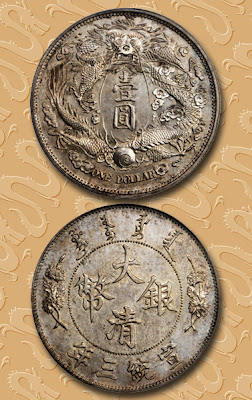
The design for this new coinage would share many design elements with preceding Imperial and provincial coinage but would have many simplified elements meant to impart the message of continued Imperial authority throughout China, an important message as the reigning Emperor Hsuan Tung was only six years old at the time. This new coinage would bear an Imperial dragon (with five toes on each foot) much like its provincial forbearers, but this dragon would dominate the entire face of the coin. The dragon glares out from 12 o’clock, its body wrapping and twisting throughout the periphery of the coin while in the center is the denomination of one Yuan essentially encircled and protected by the symbol of the Emperor. The inscription and legends also send a stripped down clear message of Qing sovereignty. At the top there is the Manchu legend owing to the dynasty’s northern progenitors, at the bottom is the date given in reign form (again a subtle assertion of the Emperor’s importance), and in the center is the simple message “Da Ch’ing Yin Pi” (Silver coin of the Great Qing). When you compare this to the contemporary provincial dollar pieces you begin to see how effective this simplified design could be, especially when compared to some of the earlier more complex provincial designs (L&M-428, 449 & 477).
Once this initial design had been completed it went through several refinements until the design was finalized. The first modification was a slight tweaking of the calligraphy in the legends and inscription along with a redesign of some of the floral sprays flanking them. Next the dragon’s whiskers were shortened so they no longer surround the denomination at center, Kann also mentions seeing a transitionary design in which the dragon bears medium length whiskers but this was never struck in any significant quantity. The final stages of design are more familiar to most collectors as the “Flying Dragon” dollars which share the same composition as the earlier models but the dragon has been refined with a smaller head, short wavy feelers and more realistically rendered clouds about it. This final design was struck in great quantity at the Tientsin and Wuchang Mints, however the uprising of 1911 in the later city forced this new design to enter circulation without ceremony as emergency military pay. Even after the establishment of the Republic of China this dragon coinage was still struck as an appropriate design, as a new Republic dollar could not be made quickly enough, and hence the dragon dollars were struck up until the introduction of the Yuan Shih-kai dollars in 1914. The piece we will be offering belongs to the first stage of modification wherein the dragon retained his long straight whiskers but the legend and inscription were changed to the style, known as the “ordinary obverse”, which remained throughout the rest of the design process.
We bring to auction a stunning example from the earliest stages of this lengthy design refinement. Graded by PCGS as SP 63+ this coin retains an amazing level of detail with all of the scales and hair fully rendered and graced with appealing luster and light toning. A rare piece which is missing from many collections and only a few examples have been brought to auction in recent years, including one featured in our December 2010 Hong Kong Sale which realized a whopping $431,250. Watch for this and other exciting rarities in the Stack’s Bowers & Ponterio August 2012 Hong Kong Sale.





